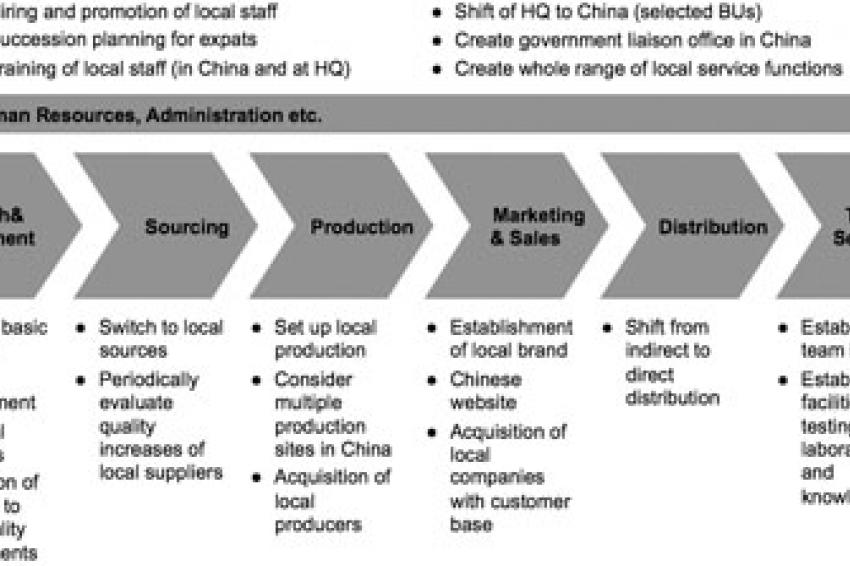Localization a Key Success Factor for Doing Business in China
14.04.2011 -
Stiff Competition - When looking at China, the competition between domestic companies and multinationals has so far largely been one between cost and customer relationship advantages on the side of the domestic players, and advantages with regard to quality and product portfolio on the side of the multinationals. Multinationals will surely try to cement these advantages by keeping their focus on product quality, and by staying ahead of the domestic competition via constant innovation and thus a superior product portfolio. However, these actions alone may not be enough to guarantee their success in China. In many areas, the quality of Chinese companies is already comparable. It will be harder for Chinese companies to close the innovation gap, but given the number of scientists available, at least the potential is already there.
Apart from maintaining their advantages, multinationals will therefore also have to work on reducing the weaknesses mentioned above. The key to this is localization, i.e., selectively shifting resources and taking up characteristics of domestic chemical companies. Of course this has consequences not only in China, but also in the traditional production countries of the multinationals.
A recent example is Bayer´s announcement to cut 4,500 jobs globally (of which about 1,700 will be in Germany) while at the same time creating 2,500 new positions in emerging markets such as China, India and Brazil.
Why does localization help to stay competitive, and what areas does localization cover?
Localization brings costs closer to the lower local Chinese level, thus reducing the cost advantage of domestic companies. At the same time, localization brings a better understanding of the local market and better customer relationships. And localization can be a beneficial strategy for essentially all aspects of the chemical value chain (fig. 1).
For research & development, there are obvious benefits to accessing the large number of Chinese scientific university graduates with salaries of only 10-20% of their Western counterparts. Though this salary gap is shrinking, it will still remain relevant in the foreseeable future. Apart from the cost aspect of hiring local scientists, they will also have a better intrinsic understanding of local product requirements - not least as they are able to communicate directly with all their Chinese customers.
Indeed, with regard to product development, most MNCs have already established capacity in China. For example, DSM just opened a Composite Resins R&D center in Shanghai, which will not only be responsible for local resin formulation but will also be the global center of excellence for specific areas of composite development. Further expansion of R&D work in China seems likely given for example BASF´s stated intent to double their local R&D staff by 2020. The only limitation of these activities is that most R&D work done by multinationals in China focuses more on development than on basic research, with IP concerns frequently cited as a reason.
Local sourcing is an obvious approach to achieving a cost structure more comparable to that of local competitors in China. Far from all raw materials are cheaper in China, but selectively employed, there is a potential for savings. As the quality of Chinese raw materials has improved (the MDI of Yantai Wanhua being an obvious example), multinationals are now much more confident to procure locally, with the added benefit of shortening the lead time. Local sourcing is natural in the case of JVs, e.g., the Cabot Bluestar JV sources its silane raw material from Bluestar, one of the parent companies. In several cases, local sourcing goes as far as multinational industry leaders not only sourcing raw materials but even products they themselves produce outside of China - and brand and market them as their own in China. With the quality of Chinese products continuing to improve, the locally available product range increasing and cost pressure on multinationals not lessening, local sourcing will become even more widespread.
Local production as a way to reduce costs even dates back from the times when products made in China were mostly for export and not for the domestic market. Increasingly, local production is now done not only for bulk products such as MDI and TDI, but also for specialty products. For example, Clariant recently announced to produce formulation inert agrochemical ingredients in China. Another way of increasing local production while getting closer to local customers is to open multiple production sites at different locations in China. AkzoNobel is following this approach with their powder coatings business, which just opened its sixth location within China in Wuhan, a region so far largely ignored by multinational chemical companies.
A fast way of getting into local production is the acquisition of a Chinese player, which of course also gives a headstart with regard to customer base and market knowledge. For example, Lanxess bought domestic producers of iron oxide pigment as well as polyols.
A similar approach may be taken in marketing and sales. Acquisition of a domestic player obviously helps establishing a local brand and may do so even without diluting the own brand. AkzoNobel just bought Prime, a major player in the Chinese market for auto refinish involved in development, manufacturing and sales for the domestic auto market. As this example shows, acquisition of a local player can be a very effective strategy in staking out a position in the fast-growing mid-market segment in China. Of course, localization simply requires making the whole range of company marketing tools available in Chinese. While most companies have achieved this for basic information such as the company website, localization is far from complete with regard to more technical and product specific information.
Localization of distribution is a two-step process. The first is making a company's products available in China in the first place. Most companies have already done this by selecting suitable distributors, though the coverage may still have gaps. In the second step, localization requires shifting the majority of sales from indirect to direct. While this step is necessary in the long run to improve profitability and increase market knowledge, it is not straightforward. When the CAS business unit of Bayer took this step a few years ago, sales staff had to be increased by a factor of five, and lengthy negotiations were necessary with existing distributors. However, the vastly improved results clearly showed it was worth doing. Still, smaller businesses still often handle the Chinese market with only two or three own sales people and continue to strongly depend on distributors.
Establishment of local technical service is another important step in localization. It generally does not reduce costs (though there are some savings to be had from the lower reliance on visits of technical staff from other regions), but it intensifies the relationship to local customers. Apart from hiring local technical staff, it also involves establishing suitable facilities for testing and duplicating customer processes in the laboratory. For example, Chemtura just opened facilities in Nanjing aimed at providing timely and regionally attuned technical service.
Apart from the various localization opportunities along the value chain, there is also potential with regard to the more general and service functions of chemical companies.
Human Resources offers many obvious measures such as the hiring and promotion of local staff and management, succession of expats by local staff, and the training of local staff. The difference between different multinational companies here is in the speed and level this staff localization has already taken place. For example, the local heads of companies such as Südchemie, Merck or DSM are already (Western-educated) Chinese.
Finally, in the long run there are number of other ways to localize central and administrative functions of multinational companies. The most obvious one will be the shift of the regional and eventually global headquarters of selected business units, the most likely being those with strong China focus, for example in some plastics and coatings raw materials.
China's history is rich with examples of foreigners entering, starting by duplicating those structures they were familiar with from their home countries, but eventually ending up adapting more and more to the local customs and conditions. And the reason was always similar - it is much easier to change the few newcomers than to change the vast majority of Chinese. With a grain of salt, this also applies to multinational companies entering China. The key to their long-term success will be to adapt as much to China as possible while keeping a few important features that will distinguish them from the local competitors.
Contact
Managm. Consult. Chemicals
RM1302, 13/F CRE Bldg.
Wanchai, Hong Kong
China
+86 1368 1873992








